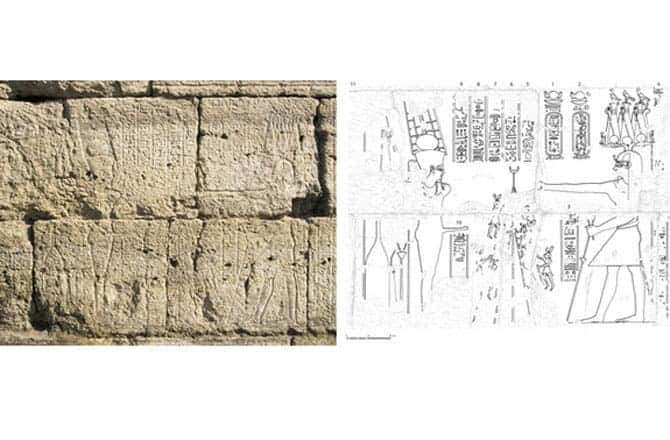
Right on the western exterior wall of the Temple of Isis at Shanhur, located just 12 miles north of the famous Luxor, archaeologists have uncovered an ancient stone carving depicting the Roman emperor Claudius dressed as a pharaoh. The scene is the most preserved out of the other 36 original scenes discovered during the 2000-2001 excavation season, after a layer of dirt kept it safe for millenia.
The scene was recorded only in 2010 after a lot of painstaking work from behalf of the team of researchers who had to decipher and put back together the eroded pieces. The stone carving speaks an elaborate tale, one of divinity both on earth in the form of the emperor/pharaoh and the heavens. More specific, Emperor Claudius, who ruled the Roman Empire between A.D. 41 to 54, is shown erecting a giant pole with a lunar crescent at the top. The emperor is depicted wearing an elaborate crown consisting of three rushes (plants) set on ram horns with three falcons sitting on top, while the god Min is shown wearing his own crown and has an erect penis, because Min was a god of fertility.
In the same scene, eight men, each wearing two feathers, are shown climbing the supporting poles, with their legs dangling in midair. Egyptian rulers are shown wearing crowns like this relatively late in ancient Egyptian history, mainly after 332 B.C., and they were worn only in Egypt. After the ancient civilization was conquered by the Romans in 30 B.C., Roman Emperors were also depicted as pharaohs, Egyptologists have noted.
In ancient Egyptian culture, the pharaoh was man, ruler and god. The hieroglyphs Claudius is named the “Son of Ra, Lord of the Crowns,” and say he is “King of Upper and Lower Egypt, Lord of the Two Lands.” The writings also explain how the pole, various little people engraved on the stone and the penis flashing god all come together. Apparently, Claudius is raising the pole of the tent (or cult chapel) of Min (an ancient Egyptian god of fertility and power) and notes a date indicating a ritual like this took place around the summertime researchers say. The hieroglyphs describe Min as “the one who brings into control the warhorses, whose fear is in the Two Lands.” Min tells Claudius, “I give you the (southern) foreign lands.” This is possibly a very important piece of historical information since the lands surrounding the Nile river are comprised of mineral-rich desserts.
Interestingly enough, Emperor Claudius never visited Egypt, but like ancient rulers he need not be present in his lands to be worshiped and honored. News like this travel all the way to Rome, and it must have surely pleased him. The findings were documented in a paper published in the journal Zeitschrift für ägyptische Sprache und Altertumskunde. The team was comprised of researchers from Swansea University and KU Leuven University in Belgium.






